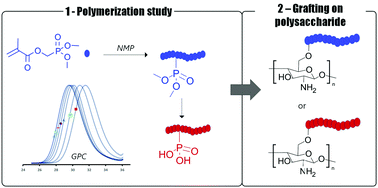Phosphorus-containing polymers synthesised via nitroxide-mediated polymerisation and their grafting on chitosan by grafting to and grafting from approaches†
Abstract
The phosphonated methacrylate dimethyl(methacryloyloxy)methyl phosphonate (MAPC1) was polymerised via nitroxide-mediated polymerisation (NMP). Kinetic monitoring of the NMP of MAPC1 (with 10 mol% of styrene as comonomer) initiated with the SG1-terminated alkoxyamine (BlocBuilder) demonstrated good control of the polymerisation. Poly(dimethyl(methacryloyloxy)methyl phosphonic acid) (hPMAPC1) was obtained by deprotection of the SG1-capped PMAPC1. The “living” polymers were then grafted to the polysaccharide chitosan (CTS) to prepare a biohybrid material, in order to modify the chitosan properties with the specific properties of the phosphorus-based polymers. A grafting from strategy was also investigated by reacting MAPC1 and hMAPC1 monomers with a macroalkoxyamine-functionalised CTS in aqueous media yielding up to 35 wt% of grafted polymer. PMAPC1 and hPMAPC1 possess attractive properties, such as being fire retardant and anticorrosive and having specific affinity for metallic ions including rare earth metals. The graft-modified CTS may be a promising candidate for applications related to (waste)water treatment, anticorrosion coatings or flame retardancy.



 Please wait while we load your content...
Please wait while we load your content...